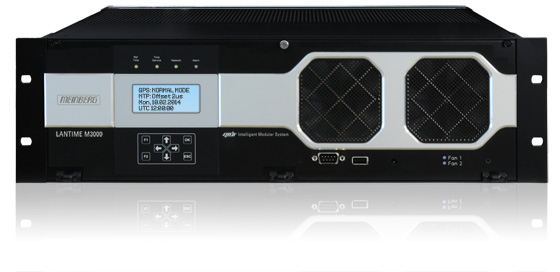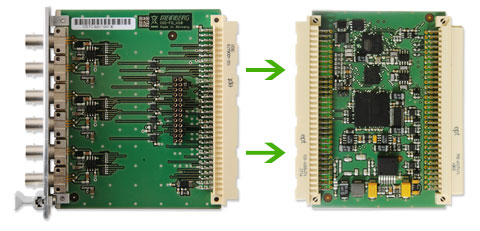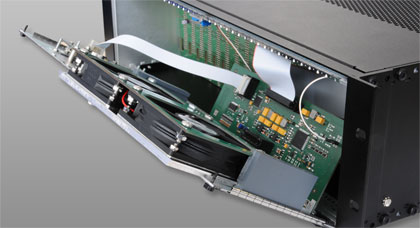Meinberg LANTIME M3000 - Synchronization Center for your Application
Key Features:
- Selectable Reference Sources:
GPS - Satellite receiver for the Global Positioning System
GNS - Combined GPS / GLONASS / Galileo / BeiDou satellite receiver (can also be used for mobile applications)
MRS - GPS, PPS, 10 MHz, PTP, NTP Multi Reference Source (several reference sources, adjustable following priority of signal) - Optimized space usage
- Synchronization of NTP and SNTP compatible clients
- Up to 24 additional LAN ports
- Up to 10 PTP (IEEE 1588-2008) modules
- Web based status and configuration interface and console based graphical configuration utility
- IMS - Intelligent Modular System platform
- Redundant power and receiver option
- Hot Plug
- Arbitrary combinations of modules
- Our LANTIME time server can be provided with a large number of additional output options:
IRIG Time Code, frequency synthesizer and programmable pulse outputs are only a few of the many expansion options for your NTP server.
High-End NTP Network Time Server for your Network
With up to 25,000 NTP requests per second (depening on the installed CPU module), the system is able to provide time for hundreds and thousands of NTP clients. The LANTIME CPU module supports the following protocols: NTP / SNTP (v2, v3, v4), PRP (IEC 62439-3), HTTP (S), SSH, Telnet, SNMP (v1, v2, v3), FTP, SFTP, DHCP/DHCPv6. For each system, up to 99 logical network interfaces are available (99 IPv4 and 99 IPv6 addresses). Enterprise-grade features such as IPv6/Dual Stack support, IEEE 802.1Q VLAN support, LACP/high availability bonding as well as DSCP and IEEE802.1p QoS/CoS traffic prioritization ensure that this product can be installed and operated in almost every critical environment, from a financial data center to a electrical substation or NGN telecommunication network to digital broadcasting infrastructure or air traffic control systems.
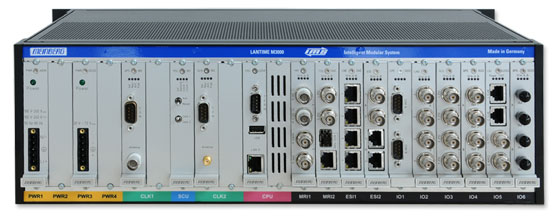
Scalable NTP Time Server System
All modules are hot-plug capable and the modules can be configured via the central web interface (from the CPU module). Almost infinite number of combinations of input and output modules are available to meet almost any synchronization task. Because of simple extension by upgrading the system with new modules the scalability of the M3000 system is ensured.
Full redundancy is also available for the clock boards, which form the core element in a Lantime system. Each clock module has an integrated highly stable oscillator that is disciplined by reference sources like GPS or GLONASS satellites or other signals, for example 1PPS, 10MHz, E1/T1 as well as IRIG Time Codes. The Meinberg MRS concept built into the IMS platform allows selecting of one or more network reference sources like NTP or PTP and all of these time and frequency references can be utilised in a user-defined priority order.
The standard output signals like pulses (1PPS, 1PPM and freely programmable pulses) and frequencies (10MHz, 2.048MHz, frequency synthesizer 1 kHz-10MHz) are provided by two versatile I/O cards named BPE and CPE. Both of these two modules have been designed to cover a wide range of interface and signal/protocol requirements. They feature a two-tier architecture with a backend and front-end. While the back-end is responsible for internally routing the backplane IMS synchronisation signals (in case of the BPE) or for autonomously generating a wide range of different signals by using a microprocessor (on a CPE), the front-end makes a selection of the signals available on physical connectors. Due to this design, it is very easy to support a large number of different electrical or optical physical interfaces, like BNC, SMA, Twinax, 2-pin DFK, DSUB9 and ST/SC FO connectors.
IEEE1588 (Precision Time Protocol, PTP) applications are supported by the new IMS-TSU module with a combined RJ45/SFP Gigabit Ethernet port and an integrated powerful 1GHz dual core service processor, allowing to synchronise hundreds of PTP slave clocks. The Meinberg IMS-TSU module is one of the most flexible PTP solutions on the market, supporting 1-step and 2-step mode, Layer 2 (Ethernet), Layer 3 (IPv4 and IPv6), End-to-End and Peer-to-Peer Delay measurements as well as Unicast, Multicast and Hybrid modes.
SLOT TYPES:
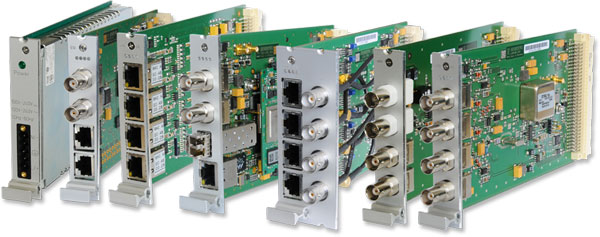
Fig.: The I/O Modules for the LANTIME M3000
- PWR: For IMS Power Supply Units (different models available supporting wide range AC and/or various DC voltage range). Four PWR slots are available for high power requirements and optional triple redundancy configurations.
- CLK: Reference clock module slot which holds either a GPS, GLONASS or DCF77 receiver including the main oscillator. The clock module provides the standard backplane signals like 1PPS, 10 MHz and serial time string. Up to two CLK slots per backplane.
- RSC: Optional Switch Module, required when using redundant clocks. Automatic, remote controlled or manual changeover of signal sources, SNMP Traps, seamless changeover of 2.048 MHz reference signals for redundant telecom applications.
- CPU: Holds a CPU module which acts as the main chassis controller and provides web interface and other management services as well as NTP (one or two onboard LAN interfaces included). The IMS platform supports one CPU slot per backplane.
-
MRI/ESI:
IMS - MRI: Standard reference input signals
IMS - ESI: Extended reference input signals
Both MRI and ESI slots can alternatively be used for additional input/output modules. - I/O: Input/Output module slot. Input modules provide additional reference signals for the main oscillator. Output modules generate new signals derived from the main clock module.
The Chassis Concept of the M3000
Although the LANTIME M3000 is available with an Active Cooling Module (ACM) with redundant fans and integrated temperature and status monitoring, it is designed to be operated in a fan-less configuration as long as there is enough rack space to allow airflow from the bottom to the top cover of the chassis. Fans, if required, can be added at any time and are field-replaceable in case of a failure.
The chassis concept of the M3000 ensures that main connectivity is provided on one single side. This includes power input as well as all synchronization and network input/output interfaces. The front panel with the backlit LC display and a service USB port as well as the serial console port also offers access to the ACM fan cartridge slot and to the menu buttons for operating the LCD menus, if required. It is possible to use the rack mounting brackets on both sides of the LANTIME M3000 chassis.


